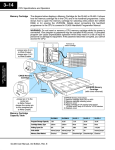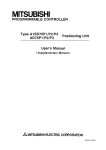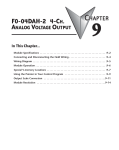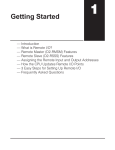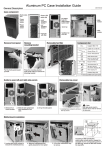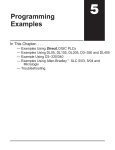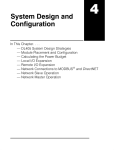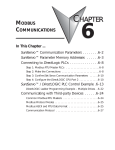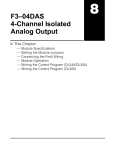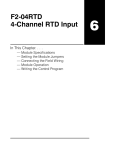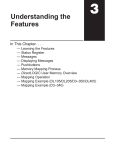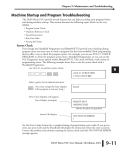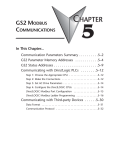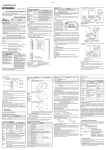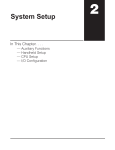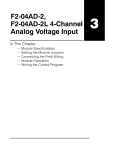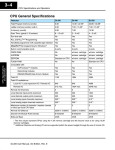Download 5 F4-08AD 8-Channel Analog Input
Transcript
F4-08AD 8-Channel Analog Input In This Chapter. . . . Ċ Module Specifications Ċ Setting the Module Jumpers Ċ Connecting the Field Wiring Ċ Module Operation Ċ Writing the Control Program 5 5–2 F4–08AD 8-Channel Analog Input Module Specifications ANALOG The F4-08AD Analog Input module provides several features and benefits. S S S S It accepts eight single-ended voltage or current inputs. Analog inputs are optically isolated from PLC logic components. The module has a removable terminal block, so the module can be easily removed or changed without disconnecting the wiring. All eight analog inputs may be read in one CPU scan (DL440 and DL450 CPUs only). INPUT 8 CHANNELS F4–08AD 0–10VDC 0–5VDC 1–5VDC ±10VDC ±5VDC 4–20mA CH1 COM CH2 COM CH3 COM CH4 COM CH5 COM CH6 COM CH7 COM CH8 COM CH1 IN CH2 IN CH3 IN CH4 IN CH5 IN CH6 IN CH7 IN CH8 IN 24VDC 0.1A 0 V F4–08AD 8-Channel Analog Input Analog Input Configuration Requirements 24 V The F4–08AD Analog Input module requires 16 discrete input points. The module can be installed in any slot of a DL405 system, including remote bases. The limitations on the number of analog modules are: S For local and expansion systems, the available power budget and discrete I/O points. S For remote I/O systems, the available power budget and number of remote I/O points. Check the user manual for your particular model of CPU for more information regarding power budget and number of local or remote I/O points. F4–08AD 8-Channel Analog Input 5–3 The following table provides the specifications for the F4–08AD Analog Input Module. Review these specifications to ensure the module meets your application requirements. Input Specifications General Specifications Number of Channels 8, single ended (one common) Input Ranges 0–5V, 0–10V, 1–5V, $5V, $10V, 0–20 mA, 4–20 mA Resolution 12 bit (1 in 4096) Active Low-pass Filtering –3 dB at 20Hz, –12 dB per octave Input Impedance 250 ohms $0.1%, 1/2W current input >20 Megohms voltage input, 1 Megohm minimum Absolute Maximum Ratings $ 45 mA, current input $75V, voltage input Conversion Time 0.4ms per channel (module conversion) 1 ms per selected channel minimum (CPU) Linearity Error (End to End) $1 count (0.025% of full scale) maximum Input Stability $1/2 count Full Scale Calibration Error (Offset error not included) $12 counts maximum , voltage input $12 counts maximum, @ 20mA current input Offset Calibration Error $2 counts maximum, unipolar voltage input $4 counts maximum, bipolar voltage input $4 counts maximum, 4 mA current input PLC Update Rate 8 Channel per scan max. Digital Input Points Required 16 (X) input points total 12 binary data bits, 3 active channel bits, Power Budget Requirement 75 mA (power from base) External Power Supply 18–30 VDC, 120 mA, class 2 Recommended Fuse 0.032 A, Series 217 fast-acting, current inputs Accuracy vs. Temperature $50 ppm / _C maximum full scale (including maximum offset change of 2 counts) 0 to 60_C (32 to 140° F) Storage Temperature –20 to 70_C (–4° F to 158° F) Relative Humidity 5 to 95% (non-condensing) Environmental Air No corrosive gases permitted Vibration MIL STD 810C 514.2 Shock MIL STD 810C 516.2 Noise Immunity NEMA ICS3–304 One count in the specification table is equal to one least significant bit of the analog data (1 in 4096). F4–08AD 8-Channel Analog Input Operating Temperature 5–4 F4–08AD 8-Channel Analog Input Setting the Module Jumpers Jumper Locations If you examine the rear of the module, you will notice four banks of jumpers. The module has several options that you can select by installing or removing these jumpers: S A bank of eight jumpers to set voltage or current input for each channel. S A bank of four jumpers to select the signal range for all active channels. S A bank of three jumpers to select the number of channels used. S A bank of two jumpers to select unipolar or bipolar signal range for all active channels. The module is set at the factory for a 4–20 mA signal range on all eight channels with unipolar polarity. The following diagram shows how the jumpers are set at the factory and describes the function of each jumper. When removing a jumper, store it by placing it on a single pin to prevent losing it. Voltage or Current Selection For Each Channel Jumper Locations 1 +4 +2 +1 2 3 4 5 6 7 Signal Range Selection 8 Jumper on = Current off = Voltage BI Number of Channels F4–08AD 8-Channel Analog Input Selecting the Number of Channels Polarity The jumpers labeled +1, +2 and +4 are used to select the number of channels that will be used. Any unused channels are not processed. For example, if you only select the first four channels, then the last four channels will not be active. Use this table to determine jumper settings. Number of Channels Selected 1 2 3 4 5 6 7 8 UNI Yes = jumper installed No = jumper removed +4 +2 +1 No No No No No Yes No Yes No No Yes Yes Yes No No Yes No Yes Yes Yes No Yes Yes Yes +4 +2 +1 Number of Channels Jumpers installed as shown selects 8-channel operation. For example: To select 3-channel operation, remove the +4 and +1 jumpers and install the +2 jumper. F4–08AD 8-Channel Analog Input 5–5 Selecting Current or Voltage Notice the eight jumpers for selecting current or voltage settings for each individual channel. For each channel install the jumper when you are using a current input or remove the jumper if using a voltage input. Selecting Input Signal and Ranges The following table shows the jumper selections for the various ranges and are grouped by bipolar and unipolar. The top portion of the table shows signal range settings for when the polarity jumper is installed in the Bi (bipolar) position, and the lower portion of the table shows settings for when the polarity jumper is installed in the Uni (unipolar) position. These settings will apply to all active channels. Bipolar Signal Range Jumper Settings –2 VDC to +2 VDC (–8mA to +8 mA) Signal Range –2.5 VDC to +2.5 VDC (–10mA to +10 mA) Signal Range –5 VDC to +5 VDC (–20mA to +20 mA) Signal Range –10 VDC to +10 VDC Polarity Bi Polarity Bi Uni Polarity Bi Unipolar Signal Range Uni Polarity Bi Signal Range Uni Uni Jumper Settings Signal Range 0 to +5 VDC (0 to +20 mA) Signal Range 0 to +10 VDC Signal Range Polarity Bi Uni Polarity Bi Uni Polarity Bi Uni F4–08AD 8-Channel Analog Input 4 to 20mA (1 VDC to 5 VDC) 5–6 F4–08AD 8-Channel Analog Input Connecting the Field Wiring Wiring Guidelines Your company may have guidelines for wiring and cable installation. If so, you should check those before you begin the installation. Here are some general things to consider. S Use the shortest wiring route whenever possible. S Use shielded wiring and ground the shield at the transmitter source. Do not ground the shield at both the module and the source. S Don’t run the signal wiring next to large motors, high current switches, or transformers. This may cause noise problems. S Route the wiring through an approved cable housing to minimize the risk of accidental damage. Check local and national codes to choose the correct method for your application. User Power Supply Requirements The F4-08AD module requires a separate power supply. The Series DL405 CPUs, D4-RS Remote I/O Controller, and D4-EX Expansion Units have built-in 24 VDC power supplies that provide up to 400mA of current. If you only have a couple analog modules, you can use this power source instead of a separate supply. If you have more than four analog modules, or you would rather use a separate supply, choose one that meets the following requirements: 24 VDC $10%, Class 2, 100 mA current (per module). Occasionally you may have the need to connect a transmitter with an unusual signal range. By changing the wiring slightly and adding an external resistor to convert the current to voltage, you can easily adapt this module to meet the specifications for a transmitter that does not adhere to one of the standard input ranges. The following diagram shows how this works. Custom Input Ranges NOTE: Remove current jumper in module. Module internal circuitry Field wiring IN Analog switch + 50mA Current Transmitter 0V R – R= (Jumper removed) 250 ohms Vmax F4–08AD 8-Channel Analog Input Imax R = value of external resistor Vmax = high limit of selected voltage range (5V or 10V) Imax = maximum current supplied by the transmitter Example: current transmitter capable of 50mA, 0 – 10V range selected. 10V R= R = 200 ohms 50mA NOTE: Your choice of resistor can affect the accuracy of the module. A resistor that has $0.1% tolerance and a $50ppm / _C temperature coefficient is recommended. F4–08AD 8-Channel Analog Input Current Loop Transmitter Impedance 5–7 Standard 4 to 20 mA transmitters and transducers can operate from a wide variety of power supplies. Not all transmitters are alike and the manufacturers often specify a minimum loop or load resistance that must be used with the transmitter. The F4-08AD provides 250 ohm resistance for each channel. If your transmitter requires a load resistance below 250 ohms, then you do not have to make any adjustments. However, if your transmitter requires a load resistance higher than 250 ohms, then you need to add a resistor in series with the module. Consider the following example for a transmitter being operated from a 36 VDC supply with a recommended load resistance of 750 ohms. Since the module has a 250 ohm resistor, you need to add an additional resistor. R + Tr * Mr R + 750 * 250 R w 500 R – resistor to add Tr – Transmitter Requirement Mr – Module resistance (internal 250 ohms) DC Supply 0V +36V Module Channel 1 – R + 250 ohms + – Two-wire Transmitter Removable Connector The F4–08AD module has a removable connector to make wiring easier. Simply remove the retaining screws and gently pull the connector from the module. F4–08AD 8-Channel Analog Input 5–8 F4–08AD 8-Channel Analog Input Wiring Diagram NOTE 1: Shields should be grounded at the signal source. NOTE 2: Unused channels should be connected to 0V or have current jumpers installed. Internal Module Wiring See NOTE 1 + CH2 Voltage Transmitter + CH1 0V – CH2 0V – Channels 3–6 are not used, See NOTE 2 CH3 CH3 0V CH4 CH4 0V CH5 CH5 0V CH6 CH6 0V CH7 2-wire 4–20mA Transmitter CH8 3-wire 4–20mA Transmitter CH7 0V CH8 CH1 IN 250 ohms IN 250 ohms CH3 IN 250 ohms CH4 IN 250 ohms CH5 IN CH6 IN CH7 IN 250 ohms F4–08AD 250 ohms 250 ohms IN + (24VDC typical) + – CH1 COM CH2 COM CH3 COM CH4 COM 250 ohms CH6 COM Jumpers for CH5, 7 & 8 are installed 24V – A to D Convertor 0–10VDC 0–5VDC 1–5VDC +10VDC +5VDC 4–20mA CH5 COM CH8 0V Optional External P/S 0V CH7 COM CH8 COM 0 V 18-30VDC CH1 IN CH2 IN CH3 IN CH4 IN CH5 IN CH6 IN CH7 IN CH8 IN 24VDC 0.1A OV More than one external power supply can be used (see channel 8). If the power supply common of an external power supply is not connected to 0V on the module, then the output of the external transmitter must be isolated. To avoid “ground loop” errors, recommended 4–20mA transmitter types are: 2 or 3 wire: Isolation between input signal and power supply. 4 wire: Isolation between input signal, power supply, and 4–20mA output. F4–08AD 8-Channel Analog Input 8 CHANNELS CH2 Analog Switch CH1 Voltage Transmitter ANALOG 24 V INPUT 5–9 F4–08AD 8-Channel Analog Input Module Operation DL430 Special Requirements Even though the module can be placed in any slot, it is important to examine the configuration if you are using a DL430 CPU. As you will see in the section on writing the program, you use V-memory locations to extract the analog data. As shown in the following diagram, if you place the module so the input points do not start on a V-memory boundary, the instructions cannot access the data. F4–08AD Correct! 8pt Input 8pt Input 16pt Input X0 – X7 X10 X20 X40 – – – X17 X37 X57 V40400 16pt Input 16pt Output V40402 V40401 MSB 16pt Output X 3 7 LSB X X 3 2 0 7 Wrong! X 2 0 F4–08AD 8pt Input 16pt Input 8pt Input 16pt Input X0 – X7 X10 X30 X40 – – – X27 X37 X57 16pt Output 16pt Output Data is split over two locations, so instructions cannot access data from a DL430. MSB XX 3 2 0 7 LSB X 2 0 MSB X 1 7 V40400 XX 1 7 0 LSB X 0 F4–08AD 8-Channel Analog Input X 3 7 V40401 5–10 F4–08AD 8-Channel Analog Input Channel Scanning Sequence Before you begin writing the control program, it is important to take a few minutes to understand how the module processes and represents the analog signals. The F4-08AD module supplies one channel of data per each CPU scan. Since there are eight channels, it can take up to eight scans to get data for all channels. Once all channels have been scanned the process starts over with channel 1. There are ways around this. Later we’ll show you how to write a program that will get all eight channels in one scan. Unused channels are not processed, so if you select only two channels, then each channel will be updated every other scan. Scan Read inputs Scan N Channel 1 Scan N+1 Channel 2 Execute Application Program Read the data . . . Store data . . . Scan N+7 Channel 8 Scan N+8 Channel 1 F4–08AD 8-Channel Analog Input Write to outputs Even though the channel updates to the CPU are synchronous with the CPU scan, the module asynchronously monitors the analog transmitter signal and converts the signal to a 12-bit binary representation. This enables the module to continuously provide accurate measurements without slowing down the discrete control logic in the RLL program. 5–11 F4–08AD 8-Channel Analog Input Input Bit Assignments You may recall the F4–08AD module requires 16 discrete input points from the CPU. These 16 points provide: S An indication of which channel is active. S The digital representation of the analog signal. Since all input points are automatically mapped into V-memory, it is very easy to determine the location of the data word that will be assigned to the module. F4-08AD 8pt Input 8pt Input 16pt Input 16pt Input X0 – X7 X10 X20 X40 – – – X17 X37 X57 V40400 16pt Output 16pt Output V40402 V40401 MSB Bit 15 14 13 12 11 10 9 X 3 7 LSB 8 7 6 X X 3 2 0 7 5 4 3 2 1 0 X 2 0 Within this word location, the individual bits represent specific information about the analog signal. Active Channel Indicator Inputs V40401 MSB LSB 1 1 1 1 11 9 8 7 6 5 4 3 2 1 0 5 4 3 2 10 – channel inputs F4–08AD 8-Channel Analog Input The bits (inputs) shown in the diagram indicate the active channel. The next to last three bits of the V-memory location indicate the active channel. The inputs are automatically turned on and off on each CPU scan to indicate the active channel. Channel Scan Inputs Channel N 000 1 N+1 001 2 N+2 010 3 N+3 011 4 N+4 100 5 N+5 101 6 N+6 110 7 N+7 111 8 5–12 F4–08AD 8-Channel Analog Input Analog Data Bits The first twelve bits represent the analog data in binary format. Bit Value Bit Value 0 1 6 64 1 2 7 128 2 4 8 256 3 8 9 512 4 16 10 1024 5 32 11 2048 V40401 MSB LSB 1 1 1 1 1 1 9 8 7 6 5 4 3 2 1 0 5 4 3 2 1 0 – data bits Since the module has 12-bit resolution, the analog signal is converted into 4096 counts ranging from 0-4095 (212). For example, with a 0 to 10V scale, a 0V signal would be 0, and a 10V signal would be 4095. This is equivalent to a a binary value of 0000 0000 0000 to 1111 1111 1111, or 000 to FFF hexadecimal. The following diagram shows how this relates to each signal range. –10V to +10V –5V to +5V +V +V 0V – 10V 0V – 5V 4 – 20mA 1V – 5V +5V 20mA 1V 4mA 0V –V 0V 0 4095 0 4095 0 Each count can also be expressed in terms of the signal level by using the equation shown. The following table shows the smallest signal levels that will result in a change in the data value for each signal range. F4–08AD 8-Channel Analog Input Range 0 4095 Resolution + H * L 4095 H = high limit of the signal range L = low limit of the signal range Signal Span (H - L) Divide By Smallest Detectable Change $10V 20 V 4095 4.88 mV $5V 10 V 4095 2.44 mV 0 to 5V 5V 4095 1.22 mV 0 to 10V 10 V 4095 2.44 mV 1 to 5V 4V 4095 0.98 mV 16 mA 4095 3.91 mA 4 to 20mA Unusable MSB Bit 4095 When using some instructions, the most significant bit (MSB) is read along with the three active channel bits, and is not available for other uses. – unusable bit V40401 MSB LSB 1 1 1 1 11 9 8 7 6 5 4 3 2 1 0 5 4 3 2 10 Active Channel Bits F4–08AD 8-Channel Analog Input 5–13 Writing the Control Program If you have configured the F4–08AD module, use the following examples to get started writing the control program. Multiple Channels Selected Since all channels are multiplexed into a single data word, the control program must be set up to determine which channel is being read. Since the module appears as X input points to the CPU, it is very easy to use the active channel status bits to determine which channel is being monitored. F4-08AD 8pt Input X0 – X7 8pt Input 16pt Input 16pt 16pt 16pt Input Output Output X10 X20 X40 – – – X17 X37 X57 V40400 V40402 V40401 MSB Active Unusable Channel Bits Bit LSB Data Bits F4–08AD 8-Channel Analog Input 5–14 F4–08AD 8-Channel Analog Input Reading Values, DL430 CPU 4 4 4 430 440 450 The following program example shows how to read the analog data into V-memory locations with the DL430 CPU. Since the DL430 does not support the LDF instruction, you can use the LD instruction instead as shown. The example also works for DL440 and DL450 CPUs. This example will read one channel per scan, so it will take eight scans to read all eight channels. Contact SP1 is used in the example because the inputs are continually being updated. SP1 LD V40401 ANDD KFFF BCD LD V40401 ANDD K7000 SHFR K12 OUTX V3000 Loads the complete channel data word from the module into the accumulator. The V-memory location depends on the I/O configuration. See Appendix A for the memory map. This instruction masks the channel identification bits. Without this, the values used will not be correct, so do not forget to include it. Since the DL405 CPUs perform math operations in BCD, it is usually best to convert the data to BCD immediately. You can leave out this instruction if your application does not require it (such as for PID loops, which require the process variable to be in binary format). This load instruction reads the data into the accumulator again. The channel data will be pushed into the first level of the stack. This instruction masks the analog data values and leaves the channel ID bits in the accumulator. Now you have to shift the accumulator bits so the channel ID bits will result in a value between 0 and 7 (binary format). This value is the offset and indicates which channel is being processed in that scan. OUTX copies the value from the first level of the accumulator stack to a source address offset by the value in the accumulator. In this case it adds the above binary value (0–7) to V3000. The particular channel data is then stored in its respective location: For example, if the binary value of the channel select bits is 0, then channel 1 data is stored in V-memory location V3000 (V3000 + 0) and if the binary value is 6, then the channel 7 data is stored in location V3006 (V3000 + 6). See the following table. Module Reading Stored in ... F4–08AD 8-Channel Analog Input Note, this example uses SP1, which is always on. You could also use an X, C, etc. permissive contact. Acc. Bits Offset Data Channel 1 000 0 V3000 Channel 2 001 1 V3001 Channel 3 010 2 V3002 Channel 4 011 3 V3003 Channel 5 100 4 V3004 Channel 6 101 5 V3005 Channel 7 110 6 V3006 Channel 8 111 7 V3007 F4–08AD 8-Channel Analog Input Single Channel Selected 4 4 4 430 440 450 5–15 Since you do not have to determine which channel is selected, the single channel program is even more simple. SP1 LD or LDF BCD OUT V3000 When X34 is on, channel 1 data is being sent to the CPU. Use the LD instruction when using a DL430 CPU.* The BCD instruction converts the data from binary to BCD. You can leave out this instruction if your application does not require it. The OUT instruction stores the data in V3000. Note: This example uses SP1, which is always on. You could also use an X, C, etc. permissive contact. * Remember, before the BCD instruction is executed, the DL430 requires an additional instruction to mask out the first four bits that are brought in with the LD instruction. An example of how to do this using an ANDD instruction is shown in the previous section. Reading Values, DL440/450 5 4 4 430 440 450 The following program example shows how to read the analog data into V-memory locations with DL440 and DL450 CPUs. Once the data is in V-memory, you can perform math on the data, compare the data against preset values, and so forth. This example will read one channel per scan, so it will take eight scans to read all eight channels. SP1 LDF X20 K12 BCD Loads the first 12 bits of channel data (starting with location X20) from the module into the accumulator. Converts the binary value in the accumulator to BCD and stores the result in the accumulator. Use this BCD conversion if you want the channel data to be stored as BCD. Do not use this instruction if you are going to send the data to an internal PID loop because the PID loop requires the PV (process variable) to be in binary format. Loads the binary value of the three channel indicator bits, plus the MSB, into the accumulator and pushes the channel data loaded into the accumulator from the first LDF instruction into the first level of the stack. X34 = X20 + 14. OUTX V3000 OUTX copies the 16 bit value from the first level of the accumulator stack to a source address offset by the value in the accumulator. In this case it adds the above binary value (which is the offset) to V3000. The particular channel data is then stored in its respective location: For example, if the binary value of the channel select bits is 0, then channel 1 data is stored in V-memory location V3000 (V3000 + 0) and if the binary value is 6, then the channel 7 data is stored in location V3006 (V3000 + 6). See the following table. Module Reading Note: This example uses SP1, which is always on. You could also use an X, C, etc. permissive contact. Acc. Bits Offset Data Stored in ... Channel 1 000 0 V3000 Channel 2 001 1 V3001 Channel 3 010 2 V3002 Channel 4 011 3 V3003 Channel 5 100 4 V3004 Channel 6 101 5 V3005 Channel 7 110 6 V3006 Channel 8 111 7 V3007 F4–08AD 8-Channel Analog Input LDF X34 K3 5–16 F4–08AD 8-Channel Analog Input Reading Eight Channels in One Scan, DL440/450 5 4 4 430 440 450 The following program example shows how to read all eight channels in one scan by using a FOR/NEXT loop. Before you choose this method, do consider its impact on CPU scan time. The FOR/NEXT routine shown here will add about 16ms (2ms/loop) to the overall scan time. If you do not need to read the analog data on every scan, change SP1 to a permissive contact (such as an X input, CR, or stage bit) to only enable the FOR/NEXT loop when it is required. NOTE: Do not use this FOR/NEXT loop program to read the module in a remote/slave arrangement; it will not work. Use one of the programs shown that reads one channel per scan. K8 SP1 FOR SP1 LDIF X20 K12 Immediately loads the first 12 bits of the data word (starting with X20) into the accumulator. The LDIF instruction will retreive the I/O points without waiting on the CPU to finish the scan. BCD Since the DL405 CPUs perform math operations in BCD, it is usually best to convert the data to BCD immediately. You can leave out this instruction if your application does not require it (such as PID loops). LDIF X34 K4 This LDIF instruction immediately loads the three channel indicator bits into the accumulator. (For this module, the last bit in the word must be read also, that’s why the K4 is used. Otherwise, only one channel will be read). OUTX V3000 NEXT Note, this example uses SP1, which is always on. You could also use an X, C, etc. permissive contact. F4–08AD 8-Channel Analog Input Scaling the Input Data Starts the FOR/NEXT loop. The constant (K8) specifies how many times the loop will execute. Enter a constant equal to the number of channels you are using. For example, enter K4 if you’re using 4 channels. The OUTX instruction stores the channel data to an address that starts at V3000 plus the channel offset. For example, if channel 3 was being read, the data would be stored in V3002 (V3000 + 2). Module Reading Acc. Bits Offset Channel 1 000 0 V3000 Channel 2 001 1 V3001 Channel 3 010 2 V3002 Channel 4 011 3 V3003 Channel 5 100 4 V3004 Channel 6 101 5 V3005 Channel 7 110 6 V3006 Channel 8 111 7 V3007 Most applications usually require measurements in engineering units, which provide more meaningful data. This is accomplished by using the conversion formula shown. You may have to make adjustments to the formula depending on the scale you choose for the engineering units. Data Stored in ... Units + A H * L 4095 H = high limit of the Engineering unit range L = low limit of the Engineering unit range A = Analog value (0 – 4095) For example, if you wanted to measure pressure (PSI) from 0.0 to 99.9 then you would have to multiply the analog value by 10 in order to imply a decimal place when you view the value with the programming software or a handheld programmer. Notice how the calculations differ when you use the multiplier. F4–08AD 8-Channel Analog Input 5–17 Analog Value of 2024, slightly less than half scale, should yield 49.4 PSI Example without multiplier Units + A H * L 4095 Units + 2024 100 * 0 4095 Example with multiplier Units + 10 A H * L 4095 Units + 20240 100 * 0 4095 Units + 49 Units + 494 Handheld Display Handheld Display V 3101 V 3100 V MON 0000 0049 V 3101 V 3100 V MON 0000 0494* *Value is more accurate Here’s how you would write the program to perform the engineering unit conversion. This example uses SP1 which is always on. You could also use an X, C, etc. permissive contact. SP1 LDF X20 K12 Since we are going to perform some math operations in BCD, this instruction converts the data format. BCD LDF K4 OUTX V3000 X1 Loads the first 12 bits of the channel data word into the accumulator. The X address depends on the I/O configuration. X34 This LDF instruction loads the three channel indicator bits, plus the MSB, into the accumulator. The channel data from the first LDF instruction is pushed into the stack. X34 = X20 + 14. The OUTX instruction stores the channel data to an address that starts at V3000 plus the channel offset. For example, if channel two was being read, the data would be stored in V3001. LD V3000 When X1 is on, channel 1 data is loaded into the accumulator. MUL K1000 Multiplies the accumulator data by 1000 (to start the conversion). DIV K4095 Divides the accumulator data by 4095. OUT V3100 Stores the result in location V3100. F4–08AD 8-Channel Analog Input 5–18 F4–08AD 8-Channel Analog Input Analog and Digital Value Conversions Sometimes it is helpful to be able to quickly convert between the signal levels and the digital values. This is especially useful during machine startup or troubleshooting. The following table provides formulas to make this conversion easier. Range If you know the digital value ... If you know the signal level ... –10V to + 10V A + 20D * 10 4095 D + 4095 (A ) 10) 20 –5V to + 5V A + 10D * 5 4095 D + 4095 (A ) 5) 10 0 to 5V A + 5D 4095 D + 4095 (A) 5 0 to 10V A + 10D 4095 D + 4095 (A) 10 1 to 5V A + 4D ) 1 4095 D + 4095 (A * 1) 4 4 to 20mA A + 16D ) 4 4095 D + 4095 (A * 4) 16 For example, if you are using the –10V to +10V range and you have measured the signal at 6V, you would use the following formula to determine the digital value that should be stored in the V-memory location that contains the data. D + 4095 (A ) 10) 20 D + 4095 (6V ) 10) 20 D + (204.75) (16) F4–08AD 8-Channel Analog Input D + 3276


















